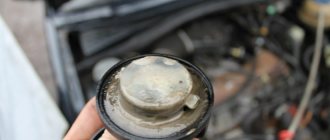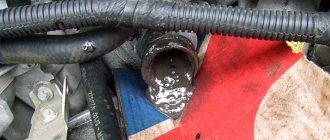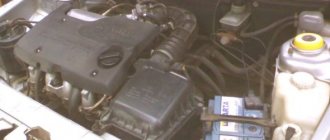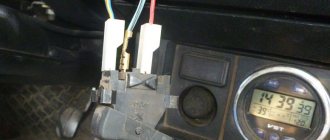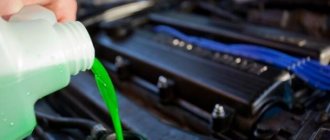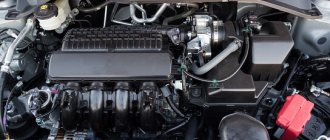One of the main systems of a car engine is the lubrication and cooling system. In normal and working condition, they are closed circuits, so the oil and antifreeze circulating in them do not mix. If the tightness of some elements is broken, oil may enter the coolant. If this happens, it is necessary to urgently determine and eliminate the cause, as well as thoroughly flush the cooling system.
- Cleaning agents
Water - Milk serum
- Fairy
- Powder machine
- Diesel fuel
Video: flushing the cooling system with diesel fuel
Cooling system flush frequency
There are no clear rules written down anywhere. But you need to take into account that in a working car - a car, a truck, mixing of oil and antifreeze does not occur - the 2 fluids are sealed and function separately.
But sometimes oil gets into the cooling system (it’s a breakdown or the owner accidentally filled it in - it doesn’t matter) and you need to urgently take the necessary actions to fix the problem. If ignored, the situation will lead to the following consequences:
- wear of bearings, since parts are negatively affected by an aggressive environment;
- risk of diesel engine jamming, water penetrates the cylinders and causes water hammer;
- contamination of the main line and pipes of the cooling system, as a result of which the latter ceases to function.
A short introductory part
The expansion tank (RB) looks quite simple: cheap and cheerful. But despite this, it is impossible to simply take it and throw it out of the car. Such an insignificant, at first glance, detail may have its own problems, and there are many of them. Often they simply explode due to high pressure, and coolant begins to fill the entire engine compartment.
For this reason, you should not wait for the tank to manifest itself at the most inopportune time. If a problem is discovered, do not put off solving it indefinitely.
But before we figure out how to check the cap of the expansion tank of a VAZ 2110 (or any other model), let’s figure out why it is needed and what important role it plays. Maybe it will still be better without him?
Non-working cleaning methods
When faced with the problem of oil getting into the car’s cooling system, drivers at home resort to different cleaning methods. But not all options are effective.
For example, they clean with “Whiteness”. But few people know that the product contains chlorine, which causes corrosion of aluminum components (and the radiator of most cars is made of this metal). In addition, “Whiteness” is not capable of properly cleaning the system, but will only cause damage.
Another option is baking soda. It effectively removes rust and scale deposits, but cannot fight oily deposits.
Installation
Before installing a new gasket, you must thoroughly clean the surface of the block and head. The sealant and remnants of the old seal are completely removed. Cleaning must be done carefully so as not to damage the contacting surfaces.
Then install a new gasket, taking into account the position of the centering bushings. The hole with copper trim should be located between the third and fourth cylinders. Before installing the head, you need to make sure that the valves of the first cylinder are closed.
When installing the head, all bolts are placed in the technological holes. The central ones are twisted first, and then the side ones. Tightening must be done strictly with a torque wrench. First, the bolts are pulled with a force of 20 Nm, then 70-85. The next time, each bolt is pulled another 90 degrees.
Then the installation of hanging elements is carried out. These are a belt, pipes, spark plugs, wires, a fuel rail and other components.
Effective folk remedies
There are also effective means, and many of them are available to almost everyone and are available in any home. But before using such methods, it is worth assessing the scale of the problem and, if possible, it is better to trust the specialists.
Milk serum
Whey is one of the effective folk methods. But some consider its effect exaggerated. However, the method is popular:
- Before use, the serum is filtered through a gauze bandage to remove existing sediment and clots.
- Liquid is added to the system and driven like this for 150-200 km. Some people simply warm up the engine and then drain the serum. If clots and oily deposits are observed, the procedure is repeated.
Coca Cola
Coca-Cola is not only a cooling drink. It is used to clean scale from dishes and electric kettles.
Many people recommend using Cola (or Sprite) as a cleanser against oil in the radiator. But you should be careful here, since this method of flushing the system is suitable for copper or brass parts. If a thin aluminum alloy is used, the liquid will not only not remove traces of oil, but will make holes in the walls and pipes, which will require repairs.
Lemon acid
To carry out cleaning you need:
- Dissolve 500-1000 g (depending on the contamination) of citric acid in 10 liters of water.
- Pour into the car radiator.
- Start the engine for 20-25 minutes.
- Disconnect and wait about 1 hour.
- Drain the dirty liquid and rinse with running water.
Fairy for dishes
Any detergent will do, but car enthusiasts recommend Fairy as the most effective and proven.
To clean the cooling system from oil deposits, you will need:
- Pour 200-250 ml of Fairy into water (the quantity is not important, it depends on the contamination of the system) and stir.
- Pour the resulting liquid into the expansion tank.
- Start the engine, wait for the filled liquid to boil, and then simply drain it. Repeat this until the system is cleared of oil, then rinse with running water until the foam completely disappears.
With this method, it is taken into account that Fairy produces a lot of foam. Therefore, when carrying out the procedure, it is worth monitoring the condition of the expansion tank.
Some drivers do not drain the solution, but try to drive 100-150 km this way. Afterwards, water is poured into the radiator and the system is completely cleaned.
Distilled water
Purified water is also considered an effective remedy if the purification procedure is carried out repeatedly.
So, how to flush the engine cooling system:
- Pour water into the expansion tank.
- Start the engine and heat the water to a temperature of 90°C.
- By pressing the gas pedal, the driver can observe how oil deposits are pushed out. This procedure is repeated 5-6 times, after which the system is considered cleared of contamination.
Conclusion
When flushing the engine, filling the cooling system, as well as draining liquids, must be done when the engine is cool, in order to eliminate the possibility of damage to the engine from temperature changes and burns if it comes into contact with the skin.
12/12/2013 We came across a dirty cooling system. The longest wait was for the Kuhlerreiniger cooling system cleaner from Liqui Moly. But I won’t talk about sad things. I drained the antifreeze, and when draining it, I pinched the pipe from the expansion tank, because this is the top point and all the oil was there, so that the oil would not drain into the radiator.
The antifreeze drained out was basically clean, but what the heck, I was in such a hurry because... Due to the weather, big minuses were transmitted, and my antifreeze was diluted with water, after they changed the head gasket, I washed the system with water and then had to dilute it. On the same day I had a train at 18:40, they sent me on a business trip to Almaty. It’s 15:00, I just started draining everything, otherwise I think I’ll leave right now, and when I arrive, the car will greet me with a defrosted cooling system)))
By the way, due to waiting for the cleaner, we had to change the washing plans, because... the temperature has not been + for a long time, but I ordered the cleaner when the weather was still above zero, and after washing it is necessary to wash the dist. Because of this, at -10 - -15, everything could already be covered with water, especially the stove. Therefore, I had to buy inexpensive Alfa antifreeze)))) without approvals, etc.
It was decided to ride it until spring, when the cooling system has already been completely flushed and the correct antifreeze has been added. I don’t recognize myself, I’m against the use of unauthorized fluids, well, there’s nothing to be done, I’ll have to sin, I don’t want to stain the new antifreeze with oil residue in the system.
In general, I drained the antifreeze from the radiator through the drain valve, then pulled it off, the pre-unscrewed and pinched pipe from the expansion tank and I will say quite a bit of oil with antifreeze ran out from it. I drained it from the head, also the drain tap, as usual in general.)
Before we start talking about flushing the engine cooling system of oil, let’s give one striking example that has been circulating for some time at the bike level. One completely “sober” guy mixed up the necks and safely poured excellent motor oil straight into the radiator expansion tank. The fact that he sobered up immediately is an understatement; the panic that arose among the “victim” was akin to a universal flood. Having abandoned all matters, the “victim” settled on the Internet with the only question - how to flush the engine cooling system of oil? This material is dedicated precisely to answers to such incidents in life.
Special means
When cleaning the cooling system from oil impurities, specially developed products are also used. Russian drivers have several effective options available to them.
ABRO AB-505 is considered popular. The drug fights limescale, rust, and removes oil stains well.
The full volume of liquid (standard 0.354 l) is poured into a system already filled with water. Start the engine for 30 minutes, with the car running at idle. Afterwards the engine is turned off and the liquid is removed. Then turn on the ignition again and, with the radiator drain hole open, constantly add water until the system is cleared of oil impurities and the water becomes clear.
An effective option is LIQUI MOLY Kuhlerreiniger. The developers assure that the product removes scale and various contaminants, including removing oil impurities. Additionally, the drug neutralizes acid and thick lubricants. And since there are no aggressive substances in the composition, it can be used with every fluid change. The product is also neutral towards plastic, rubber and metal.
To clean the tank of oil impurities, 1 package of the drug is diluted in 10 liters of antifreeze and poured into the radiator. Then they start the engine and wait 20-25 minutes. Turn off the engine, wait 3-4 hours and remove the contaminated antifreeze. The expansion tank is washed with running water. All that remains is to fill in the new solution.
Another effective product (sold in 2 bottles), according to reviews from car enthusiasts, is LAVR. The drug is designed to act in 2 stages, completely cleaning the cooling system. LAVR is capable of removing even heavy soiling.
The cleaning procedure is as follows:
- Antifreeze is completely removed from the cooling system; instead, a bottle is poured into the expansion tank to remove rust and scale. Afterwards, the system is filled to the minimum level with distilled (or at least boiled) water. Next, the engine starts and remains idling for half an hour (regardless of whether it is an automatic transmission or a manual transmission). Afterwards, the contaminated liquid is completely drained.
- Oil-emulsion deposit cleaner from 2 packages is poured into the empty radiator (after draining the liquid from 1 bottle). The system is filled with distilled water to the minimum level. Turn on the engine at idle speed for 30-40 minutes. At the end, the solution is drained, clean water is introduced into the system, the motor runs for another quarter of an hour, then the tap is opened to drain. This is repeated until clean, transparent liquid begins to flow from the tank. All that remains is to fill in new antifreeze.
Additionally, for minor contamination, drivers can use other flushing products from the LAVR line.
This includes:
- classic (Classic) liquid;
- for commercial vehicles (Fortrucks);
- synthetic (Syntetic) solution.
In addition, products from others are also offered: Bizol, Liquid Moly, Pingo. The preparations are tested, so they remove contaminants without harming the cooling system and its components.
About malfunctions and tank repairs
During operation of the machine, the following breakdowns of the expansion tank may occur;
- contamination or failure of the bypass valve of the plug;
- rupture of the tank body;
- Antifreeze leaking from under the cap.
Most car enthusiasts, when a valve or body breaks down, simply replace the part with a new one. This is justified by the lack of time for repairs and the low cost of these spare parts. Although, if desired, the burst plastic of the tank can be soldered, and the lid can be disassembled and cleaned.
Leaks from under the cork occur when the seal is not tight or due to the design features of the container. For example, on VAZ 2110 cars, a stream from the upper small fitting connected to the radiator hits directly into the neck, causing a leak. The solution is to install a more advanced tank from Priora.
Video: tank body repair
A car's expansion tank is considered one of the most reliable parts. They often last the entire life of the car, especially on foreign cars. To avoid having to change the container ahead of time, it is recommended to periodically check the condition of the valve in the lid. If it is in order, then the plastic of the vessel will not burst from high pressure.
Home →
Maintenance and Repair → Repair →
Which way is better?
There are many ways to clean the system with your own hands, but none of them can be considered universal. It all depends on the contamination of the radiator with oil deposits and the material from which the expansion tank and other parts are made.
It is recommended to buy products at car dealerships or special places (for example, service stations). As for traditional methods, when using the same Coca-Cola, you cannot be sure of the quality of cleaning. In addition, if the radiator material is unknown or the person is inexperienced, then you may have to buy a new cooling system, including a thermostat.
For example, many carbonated drinks contain phosphoric acid. It easily corrodes the pipes, and this is an additional expense. It must be taken into account that you should work with any substance carefully, because even if you exclude the risk of damage to car parts, you can get burned yourself.
Experts pay attention to the point that even after cleaning the system with professional means and thorough rinsing, an oil film remains. The radiator is considered cleaned, but it is possible to completely get rid of contaminants and wash out the oil only if the tank is desoldered.
Therefore, despite the purchased preparations and cleaning methods, in case of severe contamination it is often advised to prepare for a complete replacement of all parts of the system. Only timely repairs and car care will keep your vehicle in good condition.
Flushes that do not work or are very dangerous for engine parts
If the substance used for cleaning is simply useless, then nothing bad will happen, even the deposits suspended in the liquid will be washed away. But the unpredictability of some foreign substances in the system can cause harm, often irreparable.
Plain water
Water is used for primary and final rinsing due to its cheapness and availability. It is advisable to use water with a minimum of mineral salts that form scale, as well as without acidic properties. Ideally, distilled, but it is not free. The replacement will be thawed or boiled.
Although many water supply systems have water of quite sufficient quality. It is not suitable for batteries, but will not harm the cooling system.
Determining the degree of blockage
There are several ways to determine the degree of CO contamination:
- Engine inspection. Its overheating may be due to various reasons, but lack of cooling of the power unit is one of the main ones. If the engine constantly overheats, you need to diagnose the cooling system.
- Checking the expansion tank. The degree of clogging can be determined by the presence of sediment in the tank. But to do this, the container will have to be dismantled. It is unlikely that it will be possible to determine the presence of deposits on a reservoir installed under the hood. You can try shining a flashlight on the container. If a layer of sediment is visible at the bottom, then it’s time to rinse the CO.
- Monitoring the condition of the coolant. The presence of rust and traces of scale in the coolant indicates the need to replace the refrigerant and clean the CO.
- Inspection of hoses. Clogged pipes can be determined by disconnecting one of the hoses. Be careful as refrigerant will begin to escape from the line when disconnected. If you see that blockages inside the pipe are preventing consumables from passing through the system correctly, you should flush it.
User VChSLV published a video about cleaning and replacing the refrigerant.
What do you need to know before the procedure?
Flushing the cooling system is a serious procedure that requires car maintenance skills. Improper cleaning can lead to problems, so before starting the procedure you need to familiarize yourself not only with the structure of the mechanism, but also with the cleaning rules.
For example, if the air conditioner condenser is made of aluminum, then the use of citric acid may cause thinning of its walls . At the same time, cast iron and steel parts completely retain their integrity.
To avoid problems that arise during radical cleaning, it is recommended to carry out prevention, use the original antifreeze composition and change it on time.
Pros and cons of diesel fuel as a flushing fluid
Indeed, one of the advantages of diesel fuel in comparison with special means is the pricing policy. Flushing the engine with diesel fuel before changing the oil will be much cheaper than carrying out this procedure using purchased emulsions. The second argument in favor of diesel fuel is its use in all CIS countries for cleaning engines of domestically produced equipment, as well as its applicability for engines of special equipment. The effectiveness of this method is proven by the large number of domestically produced cars on the roads at the present time, which perfectly perform their functions despite their advanced age.
But the following fact casts doubt on the benefits of diesel fuel for the engine. Many users explain the effectiveness of diesel fuel when flushing the engine before changing the oil by the fact that it is actively used to clean engine elements during major repairs by professionals. And this is true, diesel fuel actively cleanses the elements of scale, dirt and sludge. However, opponents of the theory argue that when cleaning parts during a major overhaul, these components are not only affected by diesel fuel, but also a significant mechanical force is applied, due to which a positive result is achieved.
In addition, many experts note that when flushing the engine, diesel fuel does not break down the scale on the parts, but acts by peeling it off from the internal surfaces. Since it is almost impossible to completely remove these particles during the washing process, some of the coarse components will remain in the engine, and when oil is added, the particles will freely circulate through the system, causing damage to it and blocking small passages, thereby causing oil starvation of individual engine components. Additionally, doubts about the effectiveness of diesel fuel in cleaning the power unit are caused by the effect of the liquid on oil seals, gaskets and seals. Diesel fuel can cause their deformation, which will affect not only the functionality of the motor, but also its performance characteristics, and can cause its premature failure.
An impressive list of both positive characteristics of diesel fuel as a flushing fluid and negative factors makes you wonder whether it is possible to flush the engine with diesel fuel when changing the oil. There is no clear answer to this question. In practice, over the years of its use, diesel fuel has earned popularity in relation to the engines of domestically produced cars with significant mileage. Some owners of used foreign cars also actively use this method of cleaning the power unit and confirm its effectiveness. As for new or warranty cars, foreign cars with low mileage, engines of modern modifications, here the opinion of professionals is unequivocal - such a procedure is strictly prohibited, since it may not only not produce results, but also harm the engine. In addition, even for old cars, the procedure should be performed only when the need arises, but not at every oil change.
How to clean the tank?
How to clean the inside of the expansion tank from rust? Maybe someone has experience, tell me what kind of remedy.
PS: The tank was removed from the car.
Comments 30
WARNING: CAUSTIC SODA REACTS WITH ALUMINUM. If the radiators and other parts are aluminum, then they will be damaged.
rust in the expansion tank... tin...
It’s a shame only for those who haven’t gotten into their cooling system yet.
yes, I climbed somehow. tore off the pipe from the heater radiator, changed the expansion pipe with a cap, changed the antifreeze, clean and red and no rye
So you got the car from a good owner, unlike me, I got it from a collective farmer.
I got it from a very shitty owner, it’s just that his crooked hands didn’t reach the cooling system)
It’s a shame only for those who haven’t gotten into their cooling system yet.
In general, antifreezes have lubricating and anti-corrosion properties. Apparently you once had water in the cooling system, I would advise flushing it completely, because... excess deposits can clog it, and this already threatens with much more serious consequences than cleaning the expansion valve
try ADRILAN, there is such a household chemical product that contains caustic soda. work in rubber gloves, otherwise the skin will peel off. Sold in a pink plastic bottle.
I removed it and cleaned it with white spirit from oil and rust... you can also use Sanox
